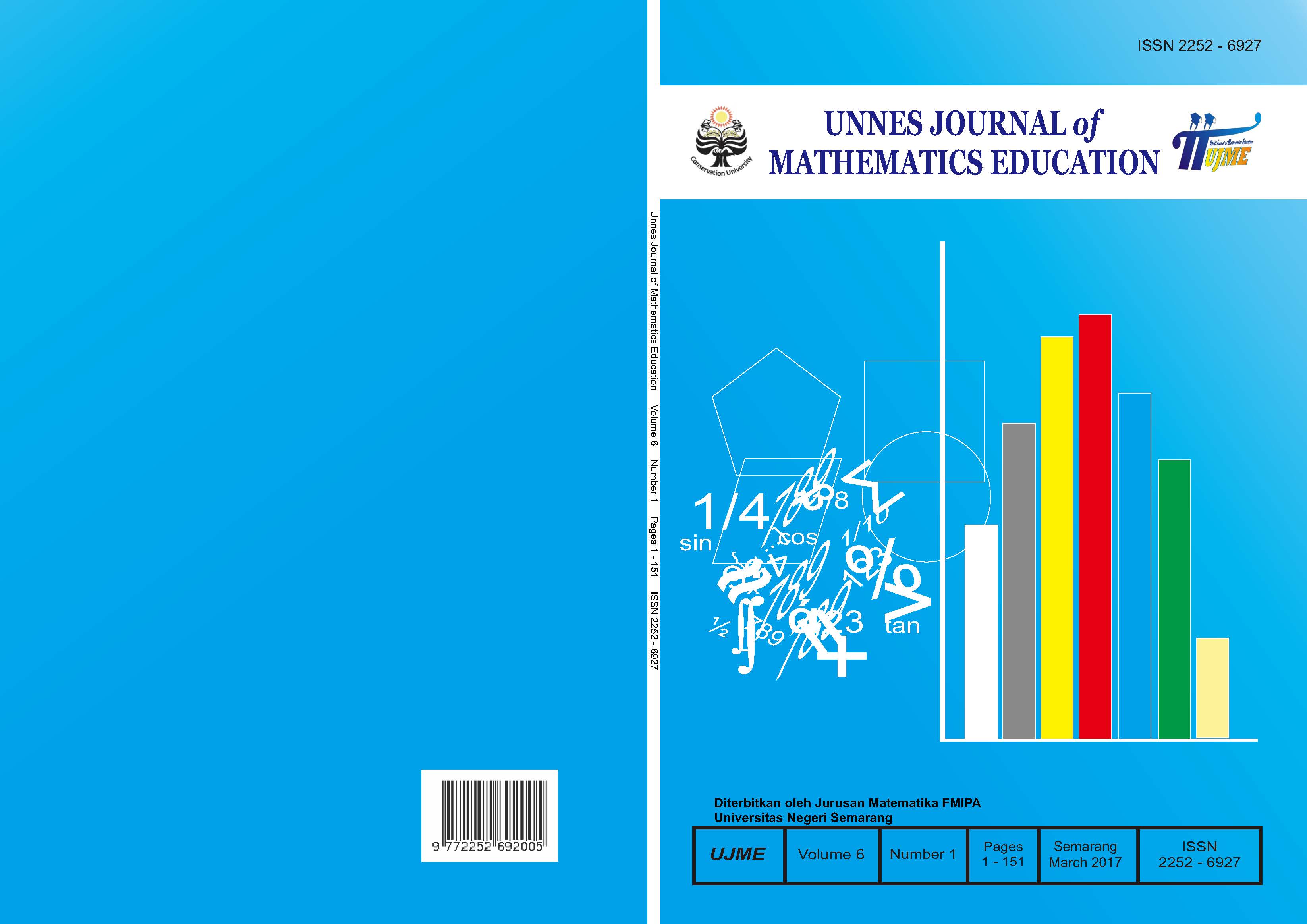Analysis Critical Thinking Stage of Eighth Grade in PBL-Scaffolding Setting To Solve Mathematical Problems
##plugins.themes.academic_pro.article.main##
Abstract
The purpose of this research was described critical thinking stage of students grade VIII in setting PBL and scaffolding to solve mathematics problems. Critical thinking stage consists of clarification, assesment, inference, and strategy/tactics. The subject were teo students in the level of capacity to think critical (uncritical, less critical, quite critical, and critical). So that this research subject was 8 students in VIII A One State Junior High School of Temanggung. The result showed a description (1) critical thinking stage of students in setting PBL, in clarification the higher level of capacity to think critical students, students can identification information from question fully, can identificatio problem became detailed, and can explored the relationship among the information; (2) a strategy of scaffolding were given by critical thinking stage and TKBK, in assesment, scaffolding had given was given hint/key classically; and (3) transformation characteristic of the critical thinking stage of students after given scaffolding, it because of habituation in setting PBL and scaffolding.
##plugins.themes.academic_pro.article.details##
References
Bikmaz, et al. (2010). Scaffolding Strategies Applied by Student Teachers to Teach Mathematics. The International Journal of Research in Teacher Education, 1 (special issue): 25-36. Tersedia di http://dergipark.ulakbim.gov.tr/ ... [diakses 7-1-2016]
Chukwuyenum, A.N. (2013). Impact of Critical thinking on Performance in Mathematics among Senior Secondary School Students in Lagos State. IOSR Journal of Research & Method in Education (IOSRÂJRME), 3 (5): 18-25. Tersedia di http://www.iosrjournals.org-/... [diakses 17-12-2015]
Fahrurazi. (2011). Penerapan Pembelajaran Berbasis Masalah untuk Meningkatkan Kemampuan Berpikir Kritis dan Komunikasi Matematis Siswa Sekolah Dasar. Jurnal UPI, Edisi khusus (1): 7689. Tersedia di http://jurnal.upi.edu/... [diakses 5-1-2016]
Jacob, S.M., & H.K. Sam. (2008). Measuring Critical thinking in Problem Solving through Online Discussion Forums in First Year University Mathematics. Proceedings of the International MultiConference of Engineers and Computer Scientists 2008, 1:19-21. Tersedia di http://www.iaeng.org/... [diakses 2-12016]
Kemendikbud. (2012). Pengembangan Kurikulum 2013. Jakarta: Kementrian Pendidikan dan Kebudayaan. Tersedia di http://fkip.uns.ac.id/... [diakses 9-22016]
Kurniasih, A.W . (2010). Penjenjangan Kemampuan Berpikir Kritis Mahasiswa Prodi Pendidikan Matematika FMIPA UNNES dalam Menyelesaikan Masalah Matematika. Thesis: Universitas Negeri Malang.
Kurniasih, A.W . (2012). Scaffolding sebagai Alternatif Upaya Meningkatkan Kemampuan Berpikir Kritis Matematika. Jurnal Kreano, 3 (2): 113124. Tersedia di http://journal.unnes.ac.id/ ... [diakses 9-2-2016]
Lange, V .L. (2002). Intructional Scaffolding: A Teaching Strategy. Tersedia di http://daretodifferentiate.wikispaces.co m/... [diakses 9-2-2016]
Marin, L.M., & D.F . Halpern. (2010). Pedagogy for developing critical thinking in adolescents: Explicit instruction produces greatest gains. ELSEVIER. Tersedia di http://www4.ncsu.edu/... [diakses 4-1-2016]
Moleong, L.J. (2007). Metodologi Penelitian Kualitatif. Bandung: Remaja Rosdakarya.
Mullis, et al. (2012). TIMSS 2011 International Results in Mathematics. United States: TIMSS & PIRLS International Study Center. Tersedia di http://timssandpirls.bc.edu/... FullBook.pdf [diakses 8-1-2016]
Paul, R., & L. Elder. (2006). The Miniature Guide to Critical Thinking Concepts and Tools. The Foundation for Critical Thinking. Tersedia di https://www.criticalthinking.org/... [diakses 4-1-2016]
Rao, G. (2013). Faculty Perception of PBL Curriculum in Melaka Manipal Medical College, Manipal, India. Department of Biochemistry, Melaka Manipal Medical College, Manipal University, 4 (2): 105111. Tersedia di http://www.ijabpt.org/...collegemanipa l-india.pdf [diakses 2-1-2016]
Radford, et al. (2014). Scaffolding learning for independence: Clarifying teacher and teaching assistant roles for children with special educational needs. Elsevier: 1-10. Tersedia di http://maximisingtas.co.uk/ ... scaffolding-1.pdf [diakses 3-8-2016]
Savery, J.R. (2006). Overview of Problem-based Learning: Definitions and Distinctions. Interdisciplinary Journal of ProblemÂBased Learning, 1 (1): 9-20. Tersedia di http://docs.lib.purdue.edu/... [diakses 8-1-2016]
Siagian, R.E.F . (2015). Pengaruh Minat dan Kebiasaan Belajar Siswa terhadap Prestasi Belajar Matematika. Jurnal Formatif, 2(2): 122-131. Tersedia di http://s3.amazonaws.com/ ... PENGA.pdf [diakses 19-7-2016]
Stuyf, R.R.V .D. (2002). Scaffolding as a Teaching Strategy. Adolescent Learning and Development. Tersedia di http://www.workplaesafety.pbworks.co m/...Learning.doc [diakses 3-8-2016]
Sugiyono. (2010). Metode Penelitian Pendidikan (Pendekatan Kuantitatif, Kualitatif, dan R&D). Bandung: Alfabeta.
Woolfolk, A. (2001). Educational Psychology. USA: Pearson Education.
